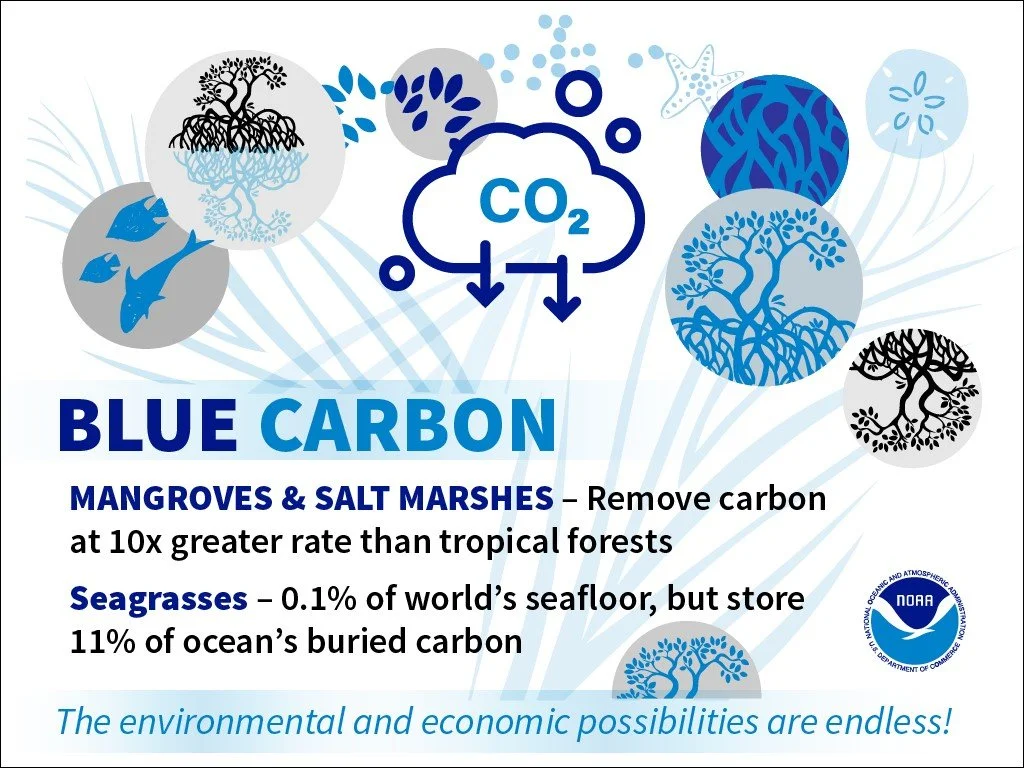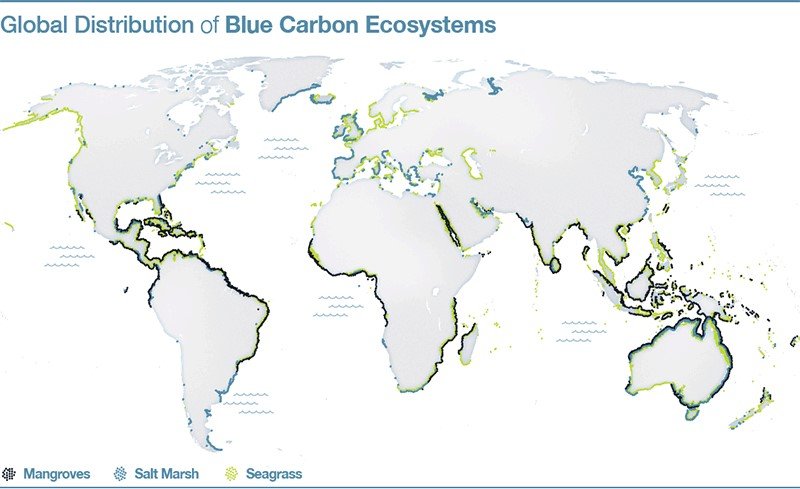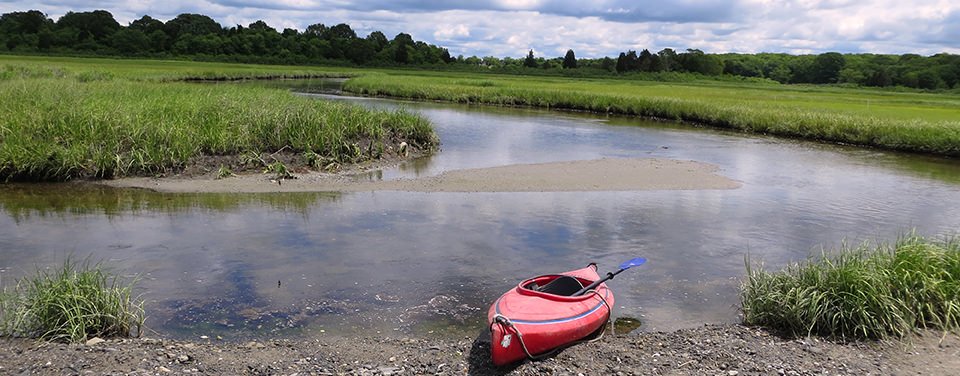Blue Carbon and the Climate Crisis
Global warming is a significant factor in climate change, arguably the biggest threat facing our planet. The rise in global temperature is due mainly to increasing concentrations of gases like carbon dioxide (CO₂). These gases trap heat in the earth’s atmosphere; the engine that fuels our planet’s changing climate patterns worldwide.
What is Blue Carbon?
Blue carbon is directly related to marine ecosystems and their ability to sequester carbon dioxide. These ecosystems are pivotal in the fight against climate change. Ecosystems like mangroves, tidal marshes, and seagrass beds also have an important role in protecting coastlines from storm surge, erosion, flooding, as well as providing vital habitat for marine life. Conversely, when blue carbon ecosystems are negatively influenced, directly or indirectly, by human activities, it undermines their ability to sequester and store carbon resulting in the release of harmful greenhouse gases.
Recent studies focused on the mitigation effects of coastal ecosystems have shown that even though they make up only two percent of the planet, coastal marine ecosystems are “ten times more effective at sequestering carbon dioxide on a per area basis per year than boreal, temperate, or tropical forests and about twice as effective at storing carbon in their soil and biomass.” And in the last decade, it is estimated that the ocean has absorbed about 23% of carbon dioxide emitted by human activities, an important contribution to the reduction of greenhouse gases. These facts are demonstrative of the value of marine ecosystems in the fight against climate change.
Blue carbon ecosystems, however, are being lost at an alarming rate ranging from 0.7 to 7 percent annually. This reduction is the direct result of coastal development, sedimentation, siltation and other human-related impacts. This situation can be ameliorated through projects designed to restore and enhance coastal wetlands. When we protect coastal ecosystems, it not only helps to reduce global warming it protects nursery habitat for fish and migratory waterfowl, coastal recreational areas and much more.
Blue Carbon Ecosystems
Blue carbon ecosystems are found along the coasts of every continent except Antarctica. They consist mainly of sea grasses, mangroves, and salt marshes. They sequester blue carbon in their vegetation and the sediment that accumulates below the water line. The sediment acts as a carbon sink sequestering carbon at a faster rate than terrestrial forests. They store even more carbon per acre than a tropical rainforest and often keep it locked away for thousands of years.
Seagrass is a plant that grows in salty coastal environments in both cold and tropical places across the globe. There are roughly 70 species of seagrasses worldwide and most have long grass-like leaves hence their name. Like the grasses that grow on land, seagrasses have roots, stems and leaves, and produce flowers and seeds. Seagrasses have the ability to form dense underwater meadows where a diverse community of animals such as fish, crabs, and turtles thrive. In fact, seagrass ecosystems are considered one of the most productive ecosystems in the world.
A mangrove is a woody tree or shrub. They tolerate the cold and, thus, are only found at tropical and subtropical latitudes near the equator. There are about 80 different species of mangroves and all grow in areas with low-oxygen soil. Mangroves often have a characteristic look that is identified by their tangle of “prop roots.” These stilt-like roots make it possible for the woody mangrove to live in zones with a daily rise and fall of tides. Their densely tangled roots slow the flow of water causing sediments to settle and create a muddy bottom. The tangled roots also are an excellent source of food and shelter for many organisms.
Salt marshes are coastal wetlands comprised of salt-tolerant grasses and other plants that are able to live in areas that flood and drain with the tides. Salt marshes are regularly submerged and as a result there is a lot of decomposing plant material that often leads to a distinctive smell most notable at low tide. This sulfurous rotten-egg smell is due to the bacteria that grow at low oxygen conditions. Salt marshes are found worldwide and most abundant at middle to high latitudes. Approximately half of our nation’s salt marshes are located along the Gulf Coast and “are an integral part of our economy and culture. They also provide essential food, refuge, and nursery habitat for more than 75 percent of fisheries species, including shrimp, blue crab, and many finfish.”
Blue carbon is also stored in seaweed, plankton, and ocean water. There is a lack of consensus on how much kelp forests contribute to the mitigation of climate change. One study conducted in Australia, estimated that “kelp forests account for 30% of the total blue carbon sequestered annually in Australia, and about 3% of the total global blue carbon budget.” Assessing the impact of kelp on the sequestration of carbon is difficult as seaweed is declining in many areas globally. “The decline of kelp forests globally includes not only the loss of critical carbon sequestration potential, but also the loss of beneficial ecosystem services, such as habitat for species, primary production, and nutrient cycling.”
The ocean’s role in carbon storage is on a far wider scale than any of the ecosystems discussed to this point as it covers nearly 70 percent of the planet. The ocean is estimated to sequester “up to 50% of all fossil fuel-related carbon dioxide emissions—20 times more than trees, other land plants, and soil combined.” One of the reasons that the ocean is such a dynamo is the biological storage capability of the phytoplankton, microscopic organisms, that live in it. These tiny organisms absorb carbon dioxide through photosynthesis, a process that converts sunlight into energy that is used by the microscopic plants to live and grow. Phytoplankton are the foundational food for the ocean’s food web. Phytoplankton are eaten by everything from microscopic animals and fish up to the blue whale, the largest organism on Earth. The carbon temporally tied up in all these creatures is transferred when they are eaten and when they die it sinks to the ocean bottom where it is sequestered presumably for very long periods of time.
Our Call to Action
The work to counteract climate change is an immense task that requires both the reduction of harmful gasses as well as the protection of blue carbon ecosystems. In terms of reduction, we need to contribute carbon dioxide to the atmosphere at a rate that is no more than nature can process. Some of the biggest sources of carbon dioxide are fossil fuels, deforestation, and agricultural practices. This means that we need to reduce our use of fossil fuels and promote less damaging forestry and agricultural practices. Some ways we as individuals can help are to drive less, use public transportation more, purchase organically grown and locally produced products, and reduce our use of plastics. These actions may be small ones in terms of the overall problem but still important. We speak with our actions as well as our words.
We must also increase the protection and enhancement of blue carbon ecosystems. These ecosystems are under intense pressure from coastal development and other damaging practices. Over the years these factors have caused the loss on a global scale of about 25 percent of all salt marshes, 30-50 percent of all mangrove forests, and 50 percent of all seagrass meadows. This loss continues with mangroves being reduced at a rate of as much as 3 percent annually, salt marshes at 1-2 percent, and sea grasses at 7 percent.






